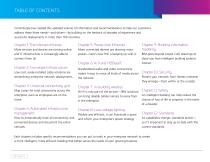
Catalog excerpts

S MART BUILDING CONNECTIVITY Photo: Robert Agua, Telikom SHAPING THE ALWAYS-ON BUSINESSES OF TOMORROW
Open the catalog to page 1
WELCOME TO A SMARTER, MORE EFFICIENT ENTERPRISE Intelligent buildings bear that label for more than one reason. On a literal level, the networked connectivity between a building’s systems make it possible for the enterprise within to automatically regulate security, environmental conditions, lighting, communications and other factors—helping maintain a welcoming atmosphere conducive to the work performed there. These networks of systems have become more critical to the efficiency, effectiveness and economy of an enterprise’s operations. Using a broader definition, intelligent buildings are...
Open the catalog to page 2
CommScope has created this updated volume of information and recommendations to help our customers address these three needs—and others—by building on the bedrock of decades of experience and successful deployments in more than 100 countries. Chapter 1: The internet of things. Chapter 5: Power over Ethernet. More services and devices are coming online, and IT infrastructure is increasingly able to connect them all. More connected devices are drawing more power—here’s how PoE is keeping up with it. Chapter 2: Converged infrastructure. Low-cost, easily-installed cable solutions are...
Open the catalog to page 3
CHANGING HOW WE WORK, TRAVEL AND LIVE The internet of things (IoT) is expanding so quickly it’s hard to stay current on its latest applications. There seems to be no limit to the ways connected devices and services help us all operate more efficiently and effectively. Soon, any discussion of intelligent buildings will include the internet of things. With 8.4 billion devices online today and another 17 billion devices expected by 20201, the impact of the IoT is already being felt in our daily lives at home, in the office and on the road. What is… the internet of things (IoT)? It’s an...
Open the catalog to page 5
The IoT in the enterprise and commercial space THE IOT IS HELPING DRIVE THE CONVERGENCE OF TRADITIONAL FACILITY AND IT INFRASTRUCTURES Today, only a small fraction of the devices in buildings are actually connected to the network. To fully realize the potential of the IoT, the challenge is to connect these standalone devices via Ethernet, cellular, Bluetooth® Low Energy, Zigbee®, Wi-Fi or other protocols, depending on the application and the device. Doing so leverages the main benefit of the IoT, which is its ability to collect data, process it, and analyze it to drive more informed,...
Open the catalog to page 6
Converged infrastructure
Open the catalog to page 7
Converged infrastructure What is… converged infrastructure? THE CONVERGENCE OF PROGRESS BLURS THE DISTINCTIONS Networking applications and technologies—like 2.5G/5G/10G Ethernet, Power over Ethernet (PoE), and HDBaseT—are continuously evolving. Yet, their evolution is bringing them all closer to a single converged infrastructure. It’s a unified system of cabling capable of supporting many diverse applications and devices, with future-ready flexibility to support emerging wired and wireless applications as well. As this convergence becomes more pronounced, new opportunities emerge to...
Open the catalog to page 8
Converged infrastructure THE ADVANTAGES: IMPROVED COST, RELIABILITY AND AGILITY From an operational standpoint, this integration is a highly preferable alternative to maintaining a collection of discrete wired and wireless topologies, each requiring its own materials, expertise and management. Alignment to a single, intelligent network infrastructure that can manage all on-site traffic in the enterprise can reduce installation costs by as much as 50 percent, and reduce operational expenses over the long term. Reducing the number of separate networks helps ensure greater reliability and...
Open the catalog to page 9
Additional resources: White paper: Fiber backbone cabling in buildings IMPLEMENTATION RECOMMENDATIONS Twisted-pair cabling provides a flexible foundation for all kinds of enterprise building systems. Category 6A cabling is at the forefront of these capabilities, boasting the bandwidth and speed for future applications as well. Here's how to make converged infrastructure even more economical and powerful in your enterprise: Know your convergent systems Recent advances have added more applications to the network. All these and more can run on converged infrastructure: • Voice and data...
Open the catalog to page 10
Universal connectivity grid
Open the catalog to page 11
Universal connectivity grid What is… the universal connectivity grid (UCG)? CONNECTING FLOOR TO CEILING AND END TO END The modern workplace is changing. It’s more dynamic and connected than ever. In an enterprise space, there are big advantages to deploying a converged infrastructure to support real estate, UCG is an approach to deploying cable infrastructure in the enterprise that provides maximum flexibility and scalability over the long term. facilities and IT services in a single architecture, as we explored in Chapter 2. Ensuring this architecture reaches every user and device—even...
Open the catalog to page 12
Universal connectivity grid Zone cabling relies on a hierarchy of infrastructure to connect the telecommunications room (TR) to each zone’s consolidation point (CP), which acts as an intermediary between the core network and the telecommunications outlet (TO). THE FREEDOM TO MOVE, ADD AND CHANGE In an enterprise space, the infrastructure for communications networks consists of two basic segments: the backbone (also known as the vertical, or riser) and the horizontal. The backbone connects telecommunications rooms (TRs) to a centrally located equipment room (ER). Backbone media is typically...
Open the catalog to page 13
IMPLEMENTATION RECOMMENDATIONS To ensure the UCG provides both connectivity and efficiency, consider several important design and deployment guidelines. Maximum cell size • TIA-162-A grid recommendations specify square cells no larger than 60 feet by 50 feet (18.3 meters by 18.3 meters). • ISO/IEC TR 24704 provides similar dimensions for hexagonal cells, specifying a radius of 40 feet (12 meters) or less. Spacing and connection counts • Cells should be evenly spaced to support easy deployment of connected devices. • The number of cable drops in each cell depends on the applications...
Open the catalog to page 14All COMMSCOPE catalogs and technical brochures
-
DATA CENTERS
62 Pages
-
Metro Cell Antenna Solutions
6 Pages










